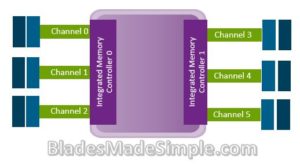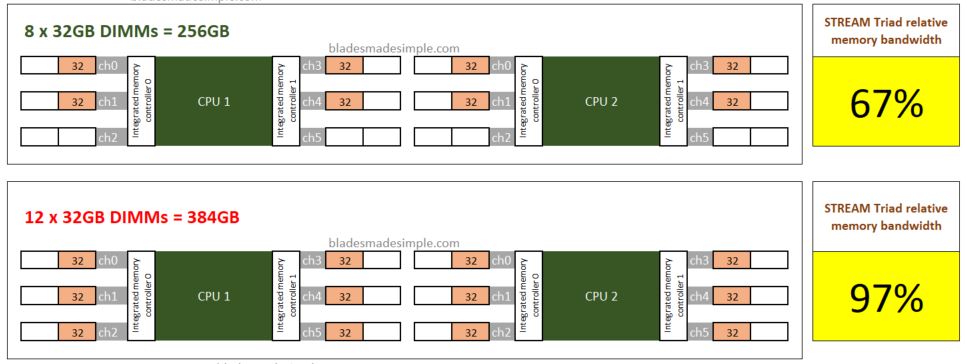As I mentioned in a previous blog post, the new Intel Xeon SP processor has more cores but it also has more memory channels. This means you should really consider changing the way you architect your blade servers.

In years past, we would populate our memory in groups of 4 for best performance. This meant that your best performing memory was 32GB, 64GB, 128GB, 256GB, 512GB. This is no longer the case. The new Intel Xeon SP processor uses 6 memory channels – 3 each going to an integrated memory controller. If you continue configuring your blade server memory with the same memory layout as you always have, you will not be able to use all 6 memory channels therefore you’ll leave performance on the table.
For example, let’s say you currently build your 2 processor blade servers with 256GB of RAM. You can still do this with the Intel Xeon SP CPU architecture, however you will only be using 4 memory channels. This equates to a relative memory bandwidth of about 67%. If, however, you change your standard architecture from 256GB to 384GB you will improve your bandwidth by an estimated 30% as shown below since all 6 memory channels are being used.
Using all 6 memory channels is not the only “balanced” design, but it is the best way to insure you get best performance. For your convenience, I’ve updated my memory cheat sheet to include a guide to help you decide what options you have, and what performance you can expect. You can download it here:
Intel_Xeon_SP_Memory_Recommendations_v4
In addition, here is a quick table of memory configurations to achieve the best performance:
| 12 DIMMs ( 6 DIMMs per CPU) | |
| DIMM Size (GB) | Total Capacity |
| 8 | 96GB |
| 16 | 192GB |
| 32 | 384GB |
| 64 | 768GB |
| 128 | 1536GB |
| 24 DIMMs ( 12 DIMMs per CPU) | |
| DIMM Size (GB) | Total Capacity |
| 8 | 192GB |
| 16 | 384GB |
| 32 | 768GB |
| 64 | 1536GB |
| 128* | 3072GB |
* requires “M” option Intel Xeon SP CPU since it’s over 768GB per CPU
 Kevin Houston is the founder and Editor-in-Chief of BladesMadeSimple.com. He has 20 years of experience in the x86 server marketplace. Since 1997 Kevin has worked at several resellers in the Atlanta area, and has a vast array of competitive x86 server knowledge and certifications as well as an in-depth understanding of VMware and Citrix virtualization. Kevin has worked at Dell EMC since August 2011 working as a Server Sales Engineer covering the Global Enterprise market from 2011 to 2017 and currently works as a Chief Technical Server Architect supporting the Central Region.
Kevin Houston is the founder and Editor-in-Chief of BladesMadeSimple.com. He has 20 years of experience in the x86 server marketplace. Since 1997 Kevin has worked at several resellers in the Atlanta area, and has a vast array of competitive x86 server knowledge and certifications as well as an in-depth understanding of VMware and Citrix virtualization. Kevin has worked at Dell EMC since August 2011 working as a Server Sales Engineer covering the Global Enterprise market from 2011 to 2017 and currently works as a Chief Technical Server Architect supporting the Central Region.
Disclaimer: The views presented in this blog are personal views and may or may not reflect any of the contributors’ employer’s positions. Furthermore, the content is not reviewed, approved or published by any employer. No compensation has been provided for any part of this blog.

Pingback: Why You Should Consider Changing Your Memory Architecture – Real World UCS